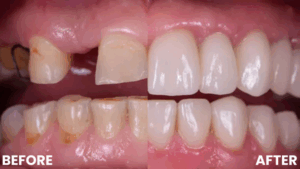Dental implants are one of the most effective and lasting solutions for replacing missing teeth. While the procedure itself is fairly straightforward, it’s important to understand what to expect during dental implant recovery so you can heal properly and get the best long-term results. At Crestline Implant Center, we’re committed to walking with you through each phase of the process, from consultation to recovery and beyond.
In this post, we’ll break down the step-by-step healing timeline for dental implants and provide tips to support your recovery every step of the way. While everyone heals at their own pace, this guide reflects what most patients can expect.
What to Expect Immediately After Surgery
Once your dental implant procedure is complete, your recovery begins. It’s normal to experience some swelling, bruising, and minor discomfort for the first 24 to 72 hours. We’ll provide personalized post-op instructions to help manage these symptoms, including guidance on pain medication, soft foods, and proper oral hygiene.
Tips for the first 48 hours:
- Apply ice packs on the cheek near the surgical area.
- Stick to soft, cold foods like yogurt, smoothies, and applesauce.
- Avoid strenuous activity and get plenty of rest.
- Take prescribed or over-the-counter medications as directed.
Following these immediate care steps can reduce swelling and promote faster healing.
Week 1: Early Healing Phase
By the end of the first week, swelling and discomfort typically begin to subside. Most patients can return to their normal daily activities, though you should still avoid chewing on the implant site and follow a soft diet.
During this early stage, your body is beginning to form new bone around the implant post, a process known as osseointegration. This is the key to long-term implant stability.
Continue to follow your oral surgeon’s instructions carefully, especially regarding:
- Rinsing with salt water or a recommended mouth rinse
- Avoiding smoking and alcohol, which can slow healing
- Practicing gentle brushing around the surgical site
If you experience unusual pain, excessive bleeding, or signs of infection, contact us immediately.
Weeks 2–4: Tissue Stabilization
At this point, the gums will continue to heal, and most of the visible signs of surgery like bruising or swelling will disappear. While you may feel “back to normal,” it’s important to remember that the implant is still stabilizing beneath the surface.
Depending on your treatment plan, a follow-up visit may be scheduled during this time to evaluate your progress.
Months 2–4: Bone Integration and Monitoring
This is the most critical phase of Dental Implants Recovery. Osseointegration continues as the titanium post fuses securely with the jawbone. While there’s little to no discomfort, patience is key. Rushing this stage can jeopardize the long-term success of your implant.
You’ll likely visit us during this time so we can monitor the healing with X-rays or scans. We’ll assess how well the bone is integrating with the implant and determine the right time to place the permanent crown or prosthetic.
Month 4 and Beyond: Final Restoration
Once osseointegration is complete, we’ll move on to the final phase: attaching the abutment and dental crown. This final restoration completes your smile and restores full chewing function.
Most patients report that their implants look, feel, and function just like natural teeth. You’ll be able to eat, speak, and smile with confidence again.
Long-Term Care After Recovery
While the recovery period technically ends once your final crown is placed, dental implant care is lifelong. Fortunately, maintaining your implants is simple and similar to caring for natural teeth.
Long-term tips include:
- Brushing twice daily and flossing once a day
- Using an antimicrobial mouth rinse if recommended
- Scheduling regular checkups and cleanings every six months
- Avoiding habits like smoking or teeth grinding that can damage implants
Final Thoughts: Trust the Process
Dental implants offer a long-lasting, natural-looking solution for missing teeth, but proper healing is essential to success. By following your post-op instructions and understanding the stages of Dental Implants Recovery, you’re setting yourself up for a strong, healthy smile for years to come.
At Crestline Implant Center, we’re with you at every step of your recovery journey. If you have questions or concerns at any point, don’t hesitate to contact our team. Your comfort and care are our highest priority.


